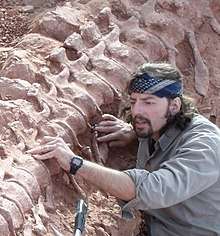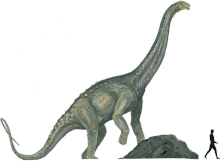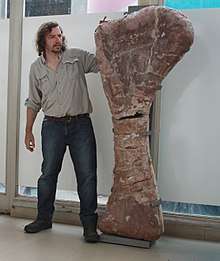Bernardo Javier González Riga
Bernardo Javier González Riga is an Argentinean paleontologist. He has discovered in the Late Cretaceous strata of the Mendoza Province (Argentina) the huge sauropod dinosaur named Notocolossus,[1] one of the largest land animal that ever found. He also described and co-described many new dinosaur species.


Scientific discoveries and their socio-cultural impact
Bernardo Javier González Riga is a researcher of the National Council of Scientific and Technical Research of Argentina. Between 2014-2017 he performs as Principal of the career of Degree in Geology in the Facultad de Ciencias Exactas y Naturales of the Universidad Nacional de Cuyo, where he also works as a professor. He also runs as Director of Dinosaur Lab he founded himself in this University. His career represents continuous searching, discoveries and protection of natural ecosystems, biodiversity and fossil remains as evidence of evolution of the species. Some of his most relevant achievements are mentioned as follows: He discovered one of the first sauropod dinosaur of Mendoza, and named it Mendozasaurus neguyelap, along with other new species of dinosaurs, turtles, fishes and flying reptiles. His studies highlight the analysis of past environments and its ecosystems. He have found dinosaurs in Argentina, Chile, Brasil, and United States. He has excavated and named, together with other paleontologists, 9 new species of dinosaurs: Mendozasaurus, Malarguesaurus, Quetecsaurus, Notocolossus, Rinconsaurus, Muyelensaurus, Ligabuesaurus, Lapampasaurus, Futalongnkosaurus, and 2 new species of fossil turtles: Linderochelys and Mendozachelys. He has also discovered the first site of fossil tracks of Mendoza, which is one of the largest of South America by the end of Cretaceous. The tracks were named Titanopodus and were made by giant herbivorous sauropod dinosaurs. They give us information about biologic aspects related to locomotion and the gregarious habits of these huge vertebrates; this enable us to understand the environment of the past regarding climate and environment crises, and the strategies of survival of the last giant dinosaurs. Among his discoveries Notocolossus gonzalezparejasi stands off, considered as one of the three largest dinosaurs of the world. aThe discovery was published in the journal Scientific Reports of Nature and has had worldwide diffusion in the international media. It has received the TOP 100 distinction by editors of Nature, for being one of the 100 most important articles of this journal, among the 20,000 articles of greatest global impact.[2] Members of this study also include Matthew Lamanna, Leonardo Ortiz David, Jorge Calvo and Juan P. Coria.

Creation of natural parks and biodiversity and fossils protection
Bernardo González Riga has been involved in numerous activities to protect natural environments, biodiversity and fossils.[3] He was one of the coordinators of the team that proposed the creation of the Cordón del Plata Provincial Park in the Andes Mountains range of Mendoza, Argentina. This initiative aimed to preserve the glaciers and rivers as vital resources, the fauna and flora, the landscape and the paleontological and archeological sites. He worked for eleven years in the creation and protection of the Cretaceous Park of Dinosaur Tracks. This natural park was discovered by González Riga himself in 2006.[4] Since then, together with his colleague, the paleontologist Dr. Mercedes Prámparo, they managed and presented projects for its preservation as a natural park.
Creation of laboratories and work teams
In 2012 Gonzalez Riga proposed the creation of the Laboratory of Dinosaurs in Mendoza. It is a research laboratory "open to society" with four complementary objectives: a) scientific research, b) teaching and training of human resources, c) paleontological heritage preservation and d) scientific disclosure. During the first five years, the Laboratory of Dinosaurs has been place for fossils exhibitions, workshops, conferences and activities in cooperation with other museums and science parks.
Education in science: solidarity and common good
González Riga as a professor not only teaches science (paleontology, evolution, geology) but also emotional intelligence related to the scientific vocation. He promotes an ethical commitment to natural environments and the fossil remains preservation as heritage for science and culture development. His teaching methods include strategies of direct communication between student-teacher and a cooperative and solidarity work, the basis for achieving interdisciplinary studies. He developed educational including the participation of young people in research, scientific expeditions and congresses and fossil footprints preservation.
References
- ↑ http://www.nature.com/articles/srep19165
- ↑ http://www.conicet.gov.ar/un-trabajo-de-investigadores-del-conicet-entre-los-cien-mas-importantes-de-la-revista-scientific-reports/
- ↑ http://www.ediunc.uncu.edu.ar/autores/index/496/Gonzlez-Riga-Bernardo
- ↑ http://onlinelibrary.wiley.com/doi/10.1111/j.1475-4983.2009.00869.x/abstract